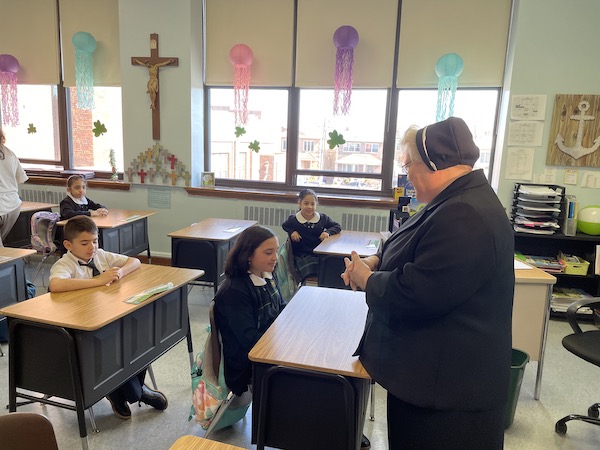
DYKER HEIGHTS — If you are of a certain age and went to Catholic school, chances are you were taught by nuns. But nowadays, wimple-adorned sisters are a rare sight, and if current trends continue, they might become a thing of the past.
There are currently 42,000 women religious in the U.S. — a 76% drop from 50 years ago, according to Georgetown University’s Center for Applied Research in the Apostolate.
If the steep decline continues, there will be fewer than 1,000 nuns by the year 2040, some experts warn.
And the numbers in the Diocese of Brooklyn aren’t much better than the national figures. There are 539 sisters here — half the number from just 10 years ago, according to Sister Maryann Seton Lopiccolo, S.C., episcopal delegate for religious in the diocese.
“Obviously, sisters are aging, and there are fewer vocations to replace them. Both of those factors play into each other,” said Sister Maryann, who belongs to the Sisters of Charity-Halifax.
Less than 1% of the 42,000 sisters nationwide are under the age of 40, and the average sister is 80 years old.
There are several factors for the decline, according to Sister Maryann, who said societal changes top the list.
“The role of women in society is very different from what it was, say, 50 or 60 years ago, when religious life was at its peak,” she explained. “When I was graduating from high school, which isn’t the Stone Age, you could be a teacher, a nurse, a secretary, or a sister. Those were the options.”
Today, by contrast, females have a more diverse world of careers to choose from.
“You could be a doctor or president. You could go into the technology world. Women can do anything,” Sister Maryann said.
The family dynamic is also at play. “People are having fewer children,” Sister Maryann said. “Years ago, people had three, four, or five kids. If one of the kids wanted to live a religious life, it didn’t totally deplete the chance for their parents to become grandparents. But today, if you have only one child and he or she wants a religious life, the parent thinks, ‘There goes my chance at grandchildren.’ ”
Ironically, another factor is the changing role of women in the Catholic Church.
While there are no female priests or deacons, women have served as Eucharistic ministers and lectors, along with other positions, thus fulfilling their desire to serve God while at the same time living a life that includes marriage and children.
“Even in the Church, there are more roles for women — parish groups, parish leadership, faith formation — there are so many ways that women can be engaged with the life and the mission of the Church without being a sister,” Sister Maryann added.
Indeed, the ranks of females working at the Vatican have also been on the rise during the papacy of Pope Francis. According to Vatican News, there are currently 1,165 women working there. A decade ago, there were 846.
Sister Shirlee Tremont, M.P.F., who teaches eighth grade at St. Bernadette Catholic Academy in Dyker Heights, knows she is a rare breed. She is one of only three members of the Sisters of Religious Teachers Filippini connected to the school, while 50-60 years ago, there were at least 15.
In the 1950s, the sisters actually lived in the school building, she said, explaining that there were rooms set aside for them with beds and other furnishings.
Sister Shirlee said she believes the decrease in sisterly vocations is part of a dynamic that turns in on itself. Because there are fewer nuns, there are fewer opportunities for girls and young women to interact with them, learn about the work they do, and perhaps contemplate entering religious life.
“I don’t know that young people today see enough (women) religious to know what religious life is all about,” she said. “And there’s probably some misconceptions.”
That’s why St. Bernadette’s students are fortunate, she said. “They get to interact with us in the classroom, at events after school, at their soccer games, and things like that. So they get a little better picture of who we are and what we do and how we live,” she explained.
On a recent Wednesday, Sister Shirlee took a break from teaching eighth grade to visit a third-grade class and gamely answered questions from the eight-year-olds about her life. The curious kids wanted to know things like what she wears to bed, what she likes to do at the beach, and who controls the TV remote control in the convent.
Ever eager to increase their numbers, congregations are making efforts to increase vocations. In some congregations, there is a sister who dedicates most of her time to speaking at high schools and colleges and appearing at prayer rallies to speak to young women.
Despite the declining population of nuns, both Sister Shirlee and Sister Maryann aren’t pessimistic.
“Religious life will never die because it’s a service. It’s a charism given by the Spirit to the Church,” Sister Maryann said. However, it may change and take other forms, she admitted. “I think we have to be welcoming to the new expressions of religious life as they come.”
“I don’t believe that the Lord has stopped calling women to religious life or men to the priesthood,” Sister Shirlee added. “I just think we’re so busy. Society is so loud everything is so rushed. We don’t have time to listen.”
